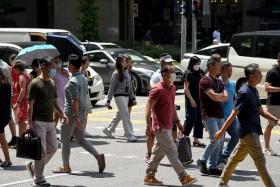S'poreans saw 2.1% rise in median real income this year despite inflation: MOM
Higher inflation ate into Singaporeans’ take-home pay this year but real median income still grew at 2.1 per cent, an improvement over 2021’s 0.9 per cent.
This year’s growth in real income - after adjusting for inflation - was nonetheless lower than the pre-Covid-19 average of 3.8 per cent for the years 2014 to 2019, when inflation was lower, the Ministry of Manpower (MOM) said on Thursday in its advance 2022 labour force report.
The report draws on data from MOM’s mid-year Comprehensive Labour Force Survey.
It showed that lower-wage workers saw stronger income growth than the median, with real income for a worker in the 20th percentile for income rising 4.8 per cent.
The growth exceeds that seen from 2014 to 2019, as well as 2021, and implies workers in the 20th percentile can expect their wages to be 55 per cent of the median, the lowest gap since 2004. MOM said.
Meanwhile, the employment rate for Singaporeans and permanent residents (PRs) rose for the second straight year to 67.5 per cent in June, higher by 2.3 percentage points than the pre-Covid rate of 65.2 per cent in 2019, and up from 67.2 per cent in 2021.
“If ranked against Organisation for Economic Co-operation and Development countries on overall employment rate, Singapore would place third,” MOM noted.
The unemployment rate fell over the year, from 3.4 per cent to 2.6 per cent for professionals, managers, executives and technicians (PMETs) and from 5.1 per cent to 4.4 per cent for non-PMETs.
The long-term unemployment rate also dropped to around pre-Covid levels for both PMETs, at 0.5 per cent, and non-PMETs, at 0.7 per cent, MOM added.
The proportion of PMETs among all employed residents increased to 64 per cent, from 62 per per cent in 2021.
“The higher share reflects a highly educated workforce and sustained employment growth in sectors such as information and communications, finance and insurance, and professional services,” MOM said.
It added: “With the economic recovery, the scale-back in Covid-19-related temporary jobs, and the tight labour market, the proportion of employees in non-permanent employment also fell back to pre-Covid-19 levels (11 per cent).”
The number and proportion of discouraged workers, which refers to those outside the labour force who are not actively looking for a job because they believe their job search would not yield results, also continued to decline - from 11,600 or 0.5 per cent of Singaporeans and PRs in 2021, to 8,900 or 0.4 per cent in 2022.
Get The New Paper on your phone with the free TNP app. Download from the Apple App Store or Google Play Store now



